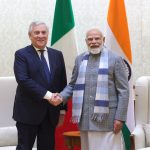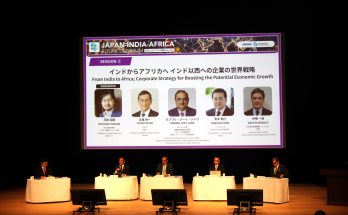 Resurgence, Renewal and Renaissance. Democracy, Development, and Demographic Dividend. Trade, Technology and Training. 2015 promises to be a year when the narratives of a rising India and Afro-optimism are set to intersect, and impart a fresh resonance to the emerging vocabulary of the multi-faceted India-Africa engagement. The increasing convergence of interests, values and a burgeoning web of win-win opportunities will be crystallised in the third India-Africa Forum Summit New Delhi will host later this year. This will be the first India-Africa summit to be hosted by the Narendra Modi government, and will reflect the mantra of “skill, scale and speed” in dynamic and evolving relations between the two growth poles of the world.
Resurgence, Renewal and Renaissance. Democracy, Development, and Demographic Dividend. Trade, Technology and Training. 2015 promises to be a year when the narratives of a rising India and Afro-optimism are set to intersect, and impart a fresh resonance to the emerging vocabulary of the multi-faceted India-Africa engagement. The increasing convergence of interests, values and a burgeoning web of win-win opportunities will be crystallised in the third India-Africa Forum Summit New Delhi will host later this year. This will be the first India-Africa summit to be hosted by the Narendra Modi government, and will reflect the mantra of “skill, scale and speed” in dynamic and evolving relations between the two growth poles of the world.
Scaling a new summit
The third summit also promises to be a milestone and will be much bigger and grander than the two previous summits held in New Delhi (2008) and Addis Ababa (2011) as this is the first time India is inviting the leaders of all 54 African countries to the forum summit. In this respect, the 2015 summit marks a new beginning as previously the participation of African leaders in the summit process was done on the basis of the Banjul formula, which entailed the participation of the leaders of around 12-14 African countries, who were represented at the summit in their capacity as the chiefs of the Regional Economic Communities (RECs). The decision to do away with the Banjul formula and invite all the leaders sends a powerful message across that the two sides are resolved to expand the scope of their partnership and infuse a new vitality into their common agenda.
The third summit is expected to raise the bar and will build upon substantive outcomes and plans outlined in the 2008 New Delhi Declaration and 2011 Addis Ababa Declaration and Africa-India Framework for Enhanced Cooperation, the all-encompassing documents that serve as templates for expanding this mutually enriching partnership revolving around enhanced trade, capacity-building and training.
Unfolding Resurgence
The context of the third summit fuels hopes of a marked upswing in the quality and quantum of the variegated India-Africa engagement. On the one hand, buoyed by a spate of second-generation economic reforms under the new government in New Delhi, the world is betting big on the India growth story, and the projected revival of the economic growth is expected to provide India more capital and resources not just for its national reconstruction, but also more financial leverage in expanding the scope of its engagement with emerging growth poles of the world like Africa. On the other hand, the African continent has been quietly and incrementally scripting a new chapter of economic resurgence, triggering a healthy competition among established and emerging players for investments in the Africa opportunity.
Africa has decisively shed the stereotype of a “Hopeless Continent” and become a “Cape of Good Hope,” with six of the world’s fastest-growing economies located in in Sub-Saharan Africa and more than thirty African countries becoming functioning democracies. Add to this potent mix, the demographic dividend, shared by both India and Africa, with the bulk of their population in the age group 19-35. The emergence of a new generation of quality-conscious middle class consumers has enhanced the attractiveness quotient of both Africa and India. What it all adds up to is that new doors are set to be opened for upscaling bilateral trade and investment, adding to economic muscle of both sides. The India-Africa trade is estimated to be around $70 billion, and if the current optimistic trends are anything to go by, the two sides should be able to ramp up their bilateral trade to $100 billion in the next 2-3 years.
Development Partnership
This economic resurgence will be also reflected in other areas of engagement. Since the two sides launched an ambitious and multi-layered summit process in the summer of 2008, India has pledged over $8.5 billion in Lines of Credit for a wide array of development projects across the emerging continent. Over 65 per cent of this soft loan package has already been disbursed. Going by past record, the new Indian government is expected to announce an ambitious multi-billion dollar developmental package at the New Delhi summit in 2015. In a signature initiative, India is also in the process of delivering on its promise of setting up over 100 training institutes in different African countries, encompassing a wide array of areas ranging from agriculture, rural development and food processing to information technology, vocational training, English language centres, and entrepreneurial development institutes. Trade, Technology and Training remains the enduring tripod that frames the multifarious India-Africa relations and will remain so in the months to come.
Knowledge Power
Many countries may have higher bilateral trade with Africa, but what sets apart India’s engagement with Africa is its focus on innovative capacity building programmes and the deployment of ICT, the country’s forte, to help build a knowledge economy in the African continent. No project illustrates this thrust on innovation and development-driven partnership better than the India-assisted Pan Pan-African e-network that provides telemedicine and tele-education to Africans living thousands of miles away by linking them with top educational institutions and super-speciality hospitals in India. Training institutes, once they start functioning, could prove to be an asset in Africa’s ongoing efforts to create a new generation of skilled and technology-empowered workers. The Make in India and Digital India missions, launched by the Modi government, will also have ripple effects in its outreach and diplomacy in Africa.
Reality Check: Strategic Depth
This picture of high hopes and renaissance-in-the-making needs a reality check as well. While the overall projection for Africa’s growth story remains resolutely bright, the recent months have brought into focus the deadly spiral of terrorism that’s ravaging a large swathe of the continent. The proliferation of terrorist and extremist groups in the continent like Al-Qaeda in the Maghreb, Nigeria-based Boko Haram, and Al-Shabaab and their suspected links with militants in other parts of the world entails a more proactive collaboration between India and Africa on the issue of terrorism. Looking ahead to the next stage in the India-Africa partnership, one can, therefore, expect a deepening of security cooperation across a spectrum of areas, including terrorism, piracy, and maritime security.
Third Summit: New Possibilities
The third India-Africa Forum Summit is, therefore, poised to be more than a showpiece diplomatic event, celebrating the exuberance, enterprise and energies of the two regions; it will be an occasion for review as well as charting the road ahead and pushing the envelope to harness new opportunities unleashed by the parallel and interlinked resurgence of India and Africa. The possibilities of mutually empowering cooperation are virtually limitless. By marrying African resources and Indian expertise, as former Ghana president John Kufuor has said famously, anything is possible.
Rewiring global governance
Besides bilateral issues, the India-Africa equations will also impact the contours of an emerging world order. As the UN celebrates its 70th anniversary, India and Africa should join hands to fructify the long-deferred dream of the reform and expansion of the UN Security Council, with seats for both New Delhi and the African continent in a reformed world body. In the intertwining of the Indian Dream and the African Dream, there is a lot at stake for the real, all-too-real world.
Author Profile

- Manish Chand is Founder and Editor-in-Chief of India Writes Network (www.indiawrites.org) and India and World, a pioneering magazine focused on international affairs. He is CEO, Centre for Global India Insights, an India-based think tank focused on global affairs.
Latest entries
 India and the WorldDecember 12, 2025India-Italy bonding: Tajani’s visit raises the bar for business, maritime ties
India and the WorldDecember 12, 2025India-Italy bonding: Tajani’s visit raises the bar for business, maritime ties In ConversationNovember 26, 2025G20 is a Force for global Good
In ConversationNovember 26, 2025G20 is a Force for global Good articlesNovember 26, 2025Rescuing G20 from North-South divide: Ubuntu Moment
articlesNovember 26, 2025Rescuing G20 from North-South divide: Ubuntu Moment India and the WorldOctober 27, 2025Modi hails the century of India and ASEAN, backs ASEAN centrality
India and the WorldOctober 27, 2025Modi hails the century of India and ASEAN, backs ASEAN centrality







